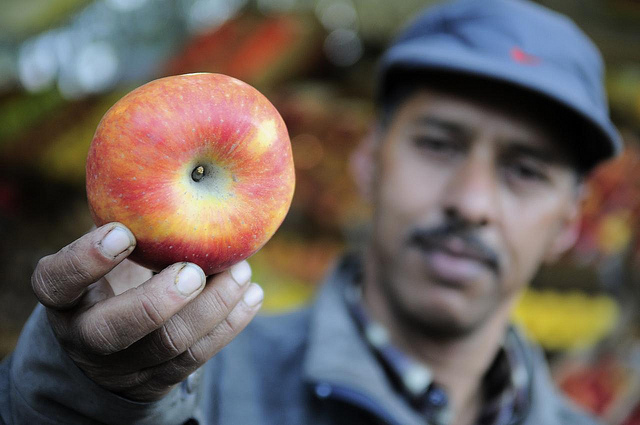Unlock the Magic in Your Story Now
Get the Free 20 questions to Ask Before Launching Your Idea workbook when you sign up for occasional updates.
Get the Free 20 questions to Ask Before Launching Your Idea workbook when you sign up for occasional updates.
Articles filed in: Marketing
Sustainable Attention
filed in Marketing, Storytelling
 The box office was due to open on Monday morning. The first fans took their place at the front of the line at 3 pm on Sunday. By midnight a hundred had gathered, and at dawn, the line snaked around on itself, as people armed with deck chairs and milk crates, queueing for the one-off $20 theatre tickets hugged the walls of the entire city block. TV cameras and newspaper reporters arrived, and word spread to nearby city offices encouraging casual theatregoers to join the line as late as 2 pm. I doubt they even reached the top of the queue before closing time.
The box office was due to open on Monday morning. The first fans took their place at the front of the line at 3 pm on Sunday. By midnight a hundred had gathered, and at dawn, the line snaked around on itself, as people armed with deck chairs and milk crates, queueing for the one-off $20 theatre tickets hugged the walls of the entire city block. TV cameras and newspaper reporters arrived, and word spread to nearby city offices encouraging casual theatregoers to join the line as late as 2 pm. I doubt they even reached the top of the queue before closing time.
There’s no doubt selling cheap tickets to the preview created a lot of buzz in the media about the show, getting the kind of attention most brands only dream of. The immediate, measurable impact and the dollar value of the exposure will have been considerable. But what happens once the cheap tickets are gone, and all that’s left is the empty milk crates piled outside the theatre doors?
We believe that attention is fuel for business growth. But it’s important to remember that there are different types and quality of attention and many ways we can buy or earn that attention. Just as we can opt to eat a chocolate bar that will give us an instant energy boost, over a plate of lentils that will nourish us. We can look for ways to tell our story that will maximise noise for a day. Or we can choose to do work over time that garners the kind of attention that sustains us.
Image by Ruth Geach.
What Are Your Words Designed To Do?
filed in Marketing, Storytelling
 How often have you read website or marketing copy that uses words we’d rarely use in conversation? The real estate agent’s copy describing homes as abodes or residences. The jargon in the consultant’s brochure. The officious tone of the notices in the dentist’s waiting room. We’re often left wondering if the purpose of the language is to confuse when it should be to connect.
How often have you read website or marketing copy that uses words we’d rarely use in conversation? The real estate agent’s copy describing homes as abodes or residences. The jargon in the consultant’s brochure. The officious tone of the notices in the dentist’s waiting room. We’re often left wondering if the purpose of the language is to confuse when it should be to connect.
Before you sit down to craft your marketing messages, it’s worth asking yourself what the words are designed to do. Are you inviting a customer to take action or hoping to persuade a doubtful audience? Are you galvanising your team around a shared goal or getting to know your customers better?
7 Questions To Guide Effective Content Creation
1. What does the audience already know?
2. What does the audience need to know and why?
3. What do you want the audience to do next?
4. What specific language, tone and calls to action do you need to use?
5. Is the copy relevant, clear and credible?
6. What’s the best medium to use in order to reach this audience?
7. How will you measure the effectiveness of your messages?
Clever copy shouldn’t simply make the writer appear smart; it should make the reader feel understood. Words are free, and they are the most potent resource every one of us has access to.
Image by Eka Shoniya.
More Than
filed in Marketing, Storytelling
 In hard-headed, rational commercial environments where tangible advantages are sought in order to make the books balance, we often overlook the value of our products and services being more than commodities. Everything a customer chooses to exchange time, attention or money for says something about who they are. Purchases are forms of self-expression. What we choose to invest in or own is an outward reflection of our internal narrative about who we are and what we value.
In hard-headed, rational commercial environments where tangible advantages are sought in order to make the books balance, we often overlook the value of our products and services being more than commodities. Everything a customer chooses to exchange time, attention or money for says something about who they are. Purchases are forms of self-expression. What we choose to invest in or own is an outward reflection of our internal narrative about who we are and what we value.
The product you’re trying to market is more than the sum of its features and benefits. For example, a car becomes more than a car when it’s part of the driver’s story. The car my husband drives is a ten-year-old, 1.1 litre Yaris with hundreds of kilometres on the clock. We bought it when we moved to Australia and shipped it interstate when we relocated. All three of our boys learned to drive in that little car. For better or worse, I don’t see us parting with the Yaris anytime soon.
The goal of every innovator and marketer is to create the thing that is not just more reliable or useful, but the one that is more meaningful in the life of the customer than he expected it to be.
Image by Bass n’ Roll.
How To Learn From The Customer Journey
 Many of the businesses you will frequent today have no idea how you became a customer. What’s worse than not knowing what brought you there is either making an incorrect assumption or not having an interest in your journey at all. It’s easier than ever in an online world to understand where customers come from, but if we want to create and grow sustainable businesses, we also need to pay attention to what they do and why they come.
Many of the businesses you will frequent today have no idea how you became a customer. What’s worse than not knowing what brought you there is either making an incorrect assumption or not having an interest in your journey at all. It’s easier than ever in an online world to understand where customers come from, but if we want to create and grow sustainable businesses, we also need to pay attention to what they do and why they come.
Whether your business operates online or offline it’s possible to get better at learning from the customer’s journey. Every day I see people walk into delis, boutiques and bookstores to browse, sometimes they leave without buying anything, but they always leave clues as to the purpose of their visit, their mindset or worldview. For example, consider the shopper who whips out his smartphone to snap a photo at the local bricks and mortar store to keep a record of the things he’d like to research or order online later.
Questions To Consider About The Customer Journey
1. What prompted the customer to visit today?
2. Where did they hear about you?
3. What did they look at, browse, pick up or buy?
4. Why did they buy?
5. What did they browse, pick up and not buy?
6. Why didn’t they buy?
7. Why were they researching or shopping?
8. How could you fulfil their needs and wants in the future?
9. What might make them return?
10.How can you create opportunities that enable you to get to know them better?
What we learn from our customers’ actions and reactions teaches us where best to focus our energy and why. Curiosity is an underrated business resource.
Image by Toshihiro Gamo.
Understanding The Value Gap
 You may have noticed how commonplace complimentary gift wrapping has become this festive season. In years gone by this service was offered by bigger department stores or as a fundraiser for charities in local shopping centres. This year though it seems that every retailer from the bookstore to the pharmacy has decided that complimentary gift wrapping might just be a way to differentiate. If the bricks and mortar retailer can’t be more convenient or cheaper, then it stands to reason that they need to add another service layer to their offering to address the perceived value gap. But just as the scripted, ‘have a great Christmas’ greeting you’ve heard the checkout operator repeat ten times before you reach him rings hollow—when everyone uses the same low-risk value adding strategy no experience feels authentic or unique.
You may have noticed how commonplace complimentary gift wrapping has become this festive season. In years gone by this service was offered by bigger department stores or as a fundraiser for charities in local shopping centres. This year though it seems that every retailer from the bookstore to the pharmacy has decided that complimentary gift wrapping might just be a way to differentiate. If the bricks and mortar retailer can’t be more convenient or cheaper, then it stands to reason that they need to add another service layer to their offering to address the perceived value gap. But just as the scripted, ‘have a great Christmas’ greeting you’ve heard the checkout operator repeat ten times before you reach him rings hollow—when everyone uses the same low-risk value adding strategy no experience feels authentic or unique.
It would be easy for retailers to panic in the wake of Amazon’s plans to reimagine the bricks and mortar shopping experience with Amazon Go. But it’s important to understand that there are as many reasons why people shop as there are to add value. Convenience, price and even service add-ons are only part of the value story. If we’re to truly differentiate our offerings we have to dig deeper and consider the value gap we’re hoping to fill for exactly what kind of customer. The good news is that not everyone wants to grab and go. There are people who want to shop locally or sustainably, and those who care about human connection more than the lowest price. You don’t have to market to everyone, but you do need to know the someone you’re filling the value gap for and what matters to them.
Image by Bill.
The Path To Business Growth
 Sal was already sweating as she blustered into the gym on Monday morning. She sat down heavily on the bench in the changing room. The things she had hastily stuffed into her gym bag tumbled out as soon as she unzipped it. Sal stopped for a second, realising she hadn’t replaced the three-day-old sweat towel that had been there all weekend. She gingerly sniffed it and sighed, then returned to spraying deodorant on her feet.
Sal was already sweating as she blustered into the gym on Monday morning. She sat down heavily on the bench in the changing room. The things she had hastily stuffed into her gym bag tumbled out as soon as she unzipped it. Sal stopped for a second, realising she hadn’t replaced the three-day-old sweat towel that had been there all weekend. She gingerly sniffed it and sighed, then returned to spraying deodorant on her feet.
Sal’s story is about a million miles from the perfect fictional narratives used to sell the fitness ideal in markets from sports apparel to workout equipment. Protein shakes to gym memberships. She will likely never become the woman represented by their avatar. And yet here she is, large as life with unmet wants and needs, hopes and dreams.
We find opportunities for business growth when we meet our customers where they are in the real world, instead of where we think they should be in our ideal version of it.
Image by Crossland Designs.
Why Story Sells
filed in Marketing, Storytelling
 The bicycle store owner was walking the customer through the range of helmets that were suitable for her teenage son. He described and demonstrated the features and benefits of three models in various price ranges. The woman seemed unsure and looked for a moment like she was about to leave with a promise to come back when she’d thought about it.
The bicycle store owner was walking the customer through the range of helmets that were suitable for her teenage son. He described and demonstrated the features and benefits of three models in various price ranges. The woman seemed unsure and looked for a moment like she was about to leave with a promise to come back when she’d thought about it.
There was no hard sell from the owner who took out his smartphone while they were chatting to show her what the mid-range helmet looked like in the flesh. He and his teenage son had just returned from a cycle tour. His son was wearing the $159 helmet in the photos. And just like that, her mind was made up.
“If you think it’s good enough for your son, then it must be good enough for mine,” she said.
We don’t just want to be persuaded; we want to believe—which is why it’s not enough to sell to the head when people buy with their hearts.
Image by thejuniorpartner.
What Are Your Marketing Goals?
 We devote a lot of time to growing our businesses—often around the loose metric of ‘more’. It’s worth defining what ‘more’ looks like for your business. You get closer to your goals when you match effort to desired outcomes, and you can’t do that without understanding which numbers you’re trying to move the needle on.
We devote a lot of time to growing our businesses—often around the loose metric of ‘more’. It’s worth defining what ‘more’ looks like for your business. You get closer to your goals when you match effort to desired outcomes, and you can’t do that without understanding which numbers you’re trying to move the needle on.
What are you measuring?
- Brand awareness.
- Market share.
- Brand engagement.
- Email open rates.
- Website visitors.
- Bounce rate.
- Social media shares.
- Customer acquisition.
- Conversion rates.
- Revenue.
- Profit margin.
- Return on marketing investment.
- Sales growth.
- Customer feedback.
- Employee engagement.
- Customer delight.
- Personal fulfilment.
- Legacy.
Sometimes the things that are top of mind are less significant than we realise and many of the things we forget to measure matter.
Image by Steve McFarland.
Worth Vs. Worthy
 As business leaders and entrepreneurs, much of our energy and resources are spent understanding how best to communicate our value to customers. Many of the most successful companies flip this thinking on its head.
As business leaders and entrepreneurs, much of our energy and resources are spent understanding how best to communicate our value to customers. Many of the most successful companies flip this thinking on its head.
If we create things that are worthy of the time, attention and money of the people we hope to serve, we don’t need to spend so much time, attention and money trying to prove their worth.
Image by Susan Frazier.
Acts Of Differentiation
 One reason we market to customers, beyond our desire to create brand awareness, is to communicate how and why our products are different and better than those of the competition. Of course, how products are created and experiences are designed can be differentiators. But we sometimes overlook opportunities to differentiate and add value—especially when it comes to our marketing tactics.
One reason we market to customers, beyond our desire to create brand awareness, is to communicate how and why our products are different and better than those of the competition. Of course, how products are created and experiences are designed can be differentiators. But we sometimes overlook opportunities to differentiate and add value—especially when it comes to our marketing tactics.
At the food market, fruit vendors vie for the attention of passers-by. The tactic adopted by most is to discount and holler. The people who use this tactic change their pitch according to the time of day or how much stock is left, so that it appeals to whatever the bargain hunter seems to be looking for. The result feels like an inconsistent, erratic, emergency (which no doubt it often is).
Contrast that with the trader who shows up with a small range of quality, seasonal produce. There is no discounting, shouting or touting at his stall. His patient, predictable, consistent approach means the same people return each week. Some send their friends, and so his loyal customer base grows over time—no hollering required. His marketing strategy is an intentional act of differentiation.
Our marketing can be as deliberate, differentiated and aligned with our values as the products we choose to make, serve and sell.
Image by CIAT.